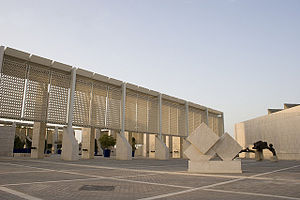Bahrain National Museum
متحف البحرين الوطني | |
 Bahrain National Museum | |
| Established | 15 December 1988 |
|---|---|
| Location | Manama, Bahrain |
| Coordinates | 26°14′26″N 50°35′54″E / 26.24056°N 50.59833°E |
| Type | Public |
| Collection size | Dilmun artifacts |
| Director | Khalifa bin Ahmed Al Khalifa[1] |
| Curator | Pierre Lombard, Nadine Boskmati-Fattouh[2] |
| Nearest car park | Free on-site |
| Website | Government site |
The Bahrain National Museum (
History

In 1957, the first exhibition of archaeological artifacts in Bahrain occurred at the Hidaya Boys School in
The modern museum was designed by Danish architects
Collections
The museum possess a collection of
Hall of Dilmun
The exhibit focuses on artifacts and the history of the
Hall of Dilmun Graves
The exhibit focuses on burial practices of the Dilmun civilization and features an actual burial mound which was transported from its site A'ali and reassembled within the museum.[8] The hall was closed for renovation in 2013 and re-opened to the public on 26 June 2018. Re-designed by French architect Didier Blin, the revamped hall features newly installed multimedia as well as findings from the most recent archaeological excavations.[2] In 2019, the Dilmun Burial Mounds of Bahrain were recognized as a UNESCO World Heritage Site.[10]
Hall of Tylos and Islam
The hall covers the Hellenic-influenced history of Bahrain from the 2nd century BC onwards as well as interactions with the
Hall of Documents and Manuscripts
Rare copies of the
Hall of Customs and Traditions
This exhibit focuses on the customs and traditions of Bahrain prior to the discovery of oil in 1932 and its subsequent modernization. Aspects of everyday life such as childhood, marriage, fashion, local religious and medical practices, and the structure of a traditional Bahraini house are exhibited.[13]
Hall of Traditional Trades and Crafts
Featuring a recreation of a traditional Bahraini
Gallery
-
A restored 1932 Buick given to Isa bin Salman Al Khalifa by the American government. Donated to the Museum in 1992.
-
The museum's exterior.
-
Earlyburial mound, originally in Hamad Town, moved to the museum.
-
Oil lamps on exhibit
-
Seals from early Dilmun period (2000-1800 B.C.).
-
Hellenic tombstones from the Tylos era.
See also
References
- ^ "Management Team". culture.gov.bh. Bahrain Authority for Culture and Antiquities - Kingdom of Bahrain. Retrieved 27 September 2019.
- ^ a b "Hall of Dilmun Graves". culture.gov.bh. Bahrain Authority for Culture and Antiquities - Kingdom of Bahrain. Retrieved 27 September 2019.
- ^ "Bahrain National Museum". Lonely Planet. Retrieved 13 September 2019.
- ^ a b c "About Bahrain National Museum". Bahrain Authority for Culture and Antiquities. Retrieved 13 September 2019.
- ^ "Bahrain National Museum". Time Out Bahrain. 27 November 2013. Retrieved 27 September 2019.
- )
- ^ "Bahrain Museum". Archived from the original on 20 November 2012. Retrieved 18 June 2012.
- ^ a b "Bahrain National Museum". Time Out Bahrain. 27 November 2013. Retrieved 28 September 2019.
- ^ "Hall of Dilmun". culture.gov.bh. Bahrain Authority for Culture and Antiquities - Kingdom of Bahrain. Retrieved 27 September 2019.
- ^ "Dilmun Burial Mounds". UNESCO World Heritage Centre. Retrieved 27 September 2019.
- ^ "Hall of Tylos and Islam". culture.gov.bh. Bahrain Authority for Culture and Antiquities - Kingdom of Bahrain. Retrieved 27 September 2019.
- ^ "Hall of Documents and Manuscripts". culture.gov.bh. Bahrain Authority for Culture and Antiquities - Kingdom of Bahrain. Retrieved 27 September 2019.
- ^ "Hall of Customs and Traditions". culture.gov.bh. Bahrain Authority for Culture and Antiquities - Kingdom of Bahrain. Retrieved 27 September 2019.
- ^ "Hall of Traditional Trades and Crafts". culture.gov.bh. Bahrain Authority for Culture and Antiquities - Kingdom of Bahrain. Retrieved 27 September 2019.
External links
- Official government website (in English)
- Photographs of Bahrain National Museum on Flickr









